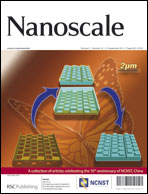Amphiphilic silane modified NaYF4:Yb,Er loaded with Eu(TTA)3(TPPO)2 nanoparticles and their multi-functions: dual mode temperature sensing and cell imaging†
Abstract
Rare-earth upconversion nanophosphors (UCNPs) have become one of the most promising luminescent materials for bio-applications, but their use still meets some limitations by difficulties in obtaining biocompatible UCNPs. To address this problem, we have developed a simple and versatile strategy for converting hydrophobic UCNPs into hydrophilic ones by amphiphilic silane modification with ultrathin thickness at room temperature (RT). In this strategy, the coating layers can also afford the place for loading with Eu(TTA)3(TPPO)2 complex which displays down conversion luminescence (DCL). Due to the UC and DC properties, we achieved the dual mode physiological range temperature sensing and dual mode cell imaging. Such novel nanomaterials offer a new surface modification strategy for the NPs that are formed in the oil phase for bio-applications.


 Please wait while we load your content...
Please wait while we load your content...